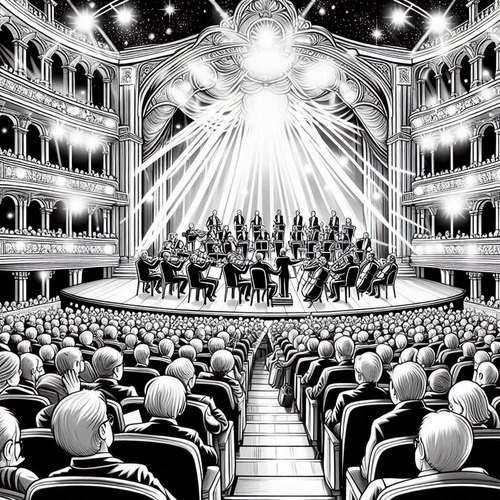Saturn, the Ringed Planet: Challenge to Random Evolution
In our vast solar system, one celestial body stands out with unparalleled majesty: Saturn, the ringed planet. With its spectacular ring system and golden hue, Saturn has captivated astronomers and stargazers for centuries. But beyond its aesthetic appeal lies a profound truth: Saturn’s extraordinary characteristics reflect intelligent design rather than random chance. In this exploration, we’ll examine how Saturn’s complexity, fine-tuning, beauty, and the latest scientific discoveries point to a divine Creator.
SATURN THE RINGED PLANET: MAGNIFICENT STRUCTURE AND DESIGN
Saturn’s unique characteristics exhibit a level of complexity and precision that strongly suggests intelligent design rather than random processes. The following features illustrate this remarkable design:
- Saturn’s ring system: unprecedented complexity and organisation: The rings consist of thousands of individual ringlets with precise gaps and divisions that maintain their structure despite forces that should cause them to dissipate. The main rings (A, B, and C) and the Cassini Division demonstrate a mathematical relationship with Saturn’s moon Mimas that speaks of intentional design rather than random formation.
- Precise density, mass and volume: With a density of 0.687 g/cm³, Saturn is the only planet in our solar system that would float if placed in a large enough body of water. This precise density, combined with its specific mass and volume, creates the perfect conditions for its extraordinary ring system to exist and suggests purposeful calibration by a Designer.
- Precise rotational period that creates a hexagonal storm at its north pole: Saturn’s north pole features a perfect hexagonal storm pattern spanning about 20,000 miles that has persisted for decades without dissipating. This geometric precision is maintained by Saturn’s exact rotational period of 10 hours and 34 minutes, demonstrating mathematical design principles that point to intentional craftsmanship.
THE FINE-TUNED POSITION OF SATURN IN OUR SOLAR SYSTEM
Beyond its own remarkable features, Saturn plays a crucial role in our solar system’s architecture—particularly in making Earth habitable. Recent scientific research has revealed Saturn’s function as a “cosmic shield” for Earth, as its powerful gravitational field deflects or captures potentially dangerous asteroids and comets that might otherwise threaten our planet.
The “Grand Tuck” theory proposed by astronomers suggests early in our solar system’s history, Saturn’s migration helped position Earth in the habitable zone where liquid water—and thus life—could exist. The mathematical precision of Saturn’s orbital resonances with Jupiter creates a stabilising effect that has helped maintain Earth’s relatively stable orbit and axial tilt, which are essential for our planet’s climate stability and seasons.
These protective qualities align perfectly with the biblical concept of a universe designed with purpose and care for human life. As Psalm 19:1 declares, “The heavens declare the glory of God; the skies proclaim the work of his hands.”
THE BEAUTY AND WONDER OF SATURN AS EVIDENCE OF A CREATOR
Perhaps one of the most compelling arguments for divine design is Saturn’s breathtaking beauty. From a purely evolutionary or materialistic perspective, such beauty serves no functional purpose. Yet Saturn displays an aesthetic harmony that transcends mere utility.
When Galileo first observed Saturn through his telescope in 1610, he was astounded by what he initially described as “ears” on the planet. As telescope technology improved, the full splendour of Saturn’s rings became apparent, inspiring generations of astronomers who often described their observations in terms of divine craftsmanship.
The beauty of Saturn reflects the biblical principle found in Romans 1:20: “God’s invisible qualities—his eternal power and divine nature—have been clearly seen, being understood from what has been made.” Saturn’s splendour exceeds any practical necessity, suggesting a Creator who values beauty for its own sake.
SATURN THE RINGED PLANET: MODERN SCIENTIFIC DISCOVERIES
Recent scientific missions, particularly NASA’s Cassini spacecraft (2004-2017), have revealed fascinating aspects of Saturn that strengthen the case for intelligent design. These discoveries challenge purely naturalistic explanations and point to a Creator’s handiwork:
- Cassini mission findings challenge naturalistic theories: Saturn’s rings appear to be remarkably young—far younger than the solar system itself. This discovery raises profound questions about ring formation and persistence, as naturalistic models struggle to explain how such a complex structure could form “recently” yet maintain its intricate organisation over time.
- Complex organic compounds on Titan suggest pre-designed elements for life: Saturn’s largest moon, Titan, features a thick atmosphere and lakes of liquid methane containing sophisticated organic compounds that appear to be pre-designed building blocks for life. Enceladus, another moon, displays perfectly calibrated water geysers erupting from a subsurface ocean—a system requiring precise balance that points to intentional design rather than chance formation.
- Mathematical constants and physical laws evident in Saturn’s systems: Golden ratio proportions can be observed in Saturn’s ring structures, while precise gravitational relationships govern interactions between the planet and its many moons. These mathematical patterns throughout Saturn’s system suggest an intelligent Designer who works through consistent mathematical principles.
CONCLUSION: SATURN THE RINGED PLANET
The evidence presented by Saturn—its complex ring system, perfectly tuned physical properties, protective role in our solar system, stunning beauty, and the latest scientific discoveries—collectively points toward intelligent design rather than random processes.
From the precise mathematics governing its rings to its critical role in Earth’s habitability, Saturn bears witness to a universe crafted with purpose and intention. As we continue to study the magnificent planet, the evidence for design only grows stronger, inviting us to consider the Master Architect behind such cosmic architecture.
In the words of Psalm 8:3-4: “When I consider your heavens, the work of your fingers, the moon and the stars, which you have set in place, what is mankind that you are mindful of them, human beings that you care for them?” Saturn’s grandeur reminds us of both the vastness of creation and the purposeful intention behind it, pointing unmistakably toward the God who designed it all.
SATURN THE RINGED PLANET: RELATED FAQs
How are Saturn’s 62+ moons significant in the creation perspective? The extraordinary number and diversity of Saturn’s moons—from Titan with its thick atmosphere to tiny moonlets embedded in the rings—display an incredible variety of designed purposes. This diversity of worlds around a single planet suggests intentional creativity rather than random formation. Many creationists point to the precise orbital resonances between these moons (where the orbital periods form exact mathematical ratios) as evidence of fine-tuning that helps maintain the stability of the entire system—just as various parts of a designed machine work together harmoniously.
How do Saturn’s distinctive colors suggest intelligent design? Saturn’s golden-yellow hue results from the precise chemical composition of its atmosphere, particularly ammonia crystals that interact with sunlight in a specific way to create its characteristic colour. This aesthetic quality serves no evolutionary advantage but appears to be designed for visual beauty when observed from Earth. The contrast between Saturn’s golden body and its bright white rings creates a visually striking appearance that many creation scientists cite as evidence of artistic intent beyond mere functional necessity—similar to how an artist carefully selects complementary colors for aesthetic effect.
Could Saturn’s rings have formed naturally, and what do recent discoveries say about their age? The 2017 Cassini mission’s final discoveries revealed that Saturn’s rings are much younger than the assumed 4.5 billion years of the solar system. Creation scientists suggest this supports the idea of a more recent creation or specific design intervention. The precise arrangement of particles within the rings—from dust-sized to house-sized, all traveling in perfect orbital lanes—displays a level of organization that intelligent design proponents argue points to purposeful engineering rather than chance collisions.
What role does Saturn play in protecting Earth that suggests intelligent design? In addition to its role as a gravitational shield deflecting comets and asteroids, Saturn works in concert with Jupiter to create a precise “orbital resonance” that helps stabilise Earth’s orbit. This creates what astronomers call “protected zones” in the solar system where Earth resides. Computer models show that without Saturn’s specific mass and distance from the sun, Earth’s orbit would become chaotic and potentially uninhabitable. This precise protective positioning appears statistically improbable by chance alone and suggests purposeful placement by an intelligent designer concerned with Earth’s habitability.
How does Saturn’s magnetic field provide evidence for design? Saturn possesses a powerful magnetic field that’s nearly perfectly aligned with its rotational axis (less than 1° difference)—a feature that distinguishes it from other planets like Earth (11° difference) or Uranus (59° difference). This precise alignment creates a protective shield around Saturn’s ring system and moons. Design proponents note the alignment couldn’t have happened by chance and helps maintain the stability of Saturn’s entire system. Additionally, Saturn’s magnetic field strength is precisely calibrated to protect its moons while allowing sufficient radiation to create the complex chemistry needed for the organic compounds found on Titan.
What biblical references might connect to Saturn specifically? While the Bible doesn’t explicitly name planets, several passages potentially reference Saturn. Job 38:31-32 mentions “the cords of Orion” and “the Bear with its cubs,” suggesting God’s specific design of celestial objects. Saturn was known to ancient peoples as a “wandering star” and may be referenced in Amos 5:26 as “Kaiwan, your star god.”
How do Saturn’s spectral rings relate to music and mathematical harmony? The spacing and resonances of Saturn’s rings follow mathematical patterns that correspond to musical intervals in what some call “cosmic harmony.” The Cassini Division, for example, results from a precise 2:1 orbital resonance with the moon Mimas—similar to an octave in music. Other ring divisions correspond to perfect fifths and fourths on the musical scale. This mathematical harmony reflects the ancient concept of “music of the spheres” and suggests an intelligent Designer who incorporated mathematical beauty into cosmic architecture. Some creation scientists point to Psalm 19:1-4, which states that the heavens “declare the glory of God” and “pour forth speech,” as a poetic reference to this mathematical harmony embedded in celestial objects like Saturn.
Editor's Pick

The Throne-Room Vision: Who Did Isaiah See?
The scene is unforgettable: Isaiah stands in the temple, and suddenly the veil between heaven and earth tears open. He [...]

The Angel of the Lord: Can We Be Certain It Was Christ All Along?
Throughout the Old Testament, a mysterious figure appears: the Angel of the LORD. He speaks as God, bears God’s name, [...]
SUPPORT US:
Feel the Holy Spirit's gentle nudge to partner with us?
Donate Online:
Account Name: TRUTHS TO DIE FOR FOUNDATION
Account Number: 10243565459
Bank IFSC: IDFB0043391
Bank Name: IDFC FIRST BANK






